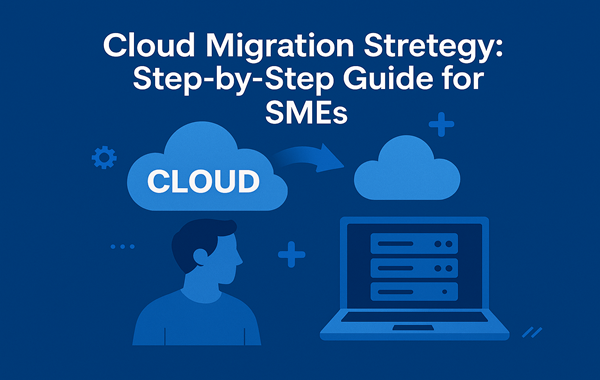Cloud Migration Strategy: Step-by-Step Guide for SMEs
In today's digital landscape, the transition to cloud computing has become a pivotal move for small and medium-sized enterprises (SMEs). As businesses seek to enhance operational efficiency, reduce costs, and improve scalability, a well-structured cloud migration strategy is essential. This guide will walk you through the critical steps involved in developing and executing a successful cloud migration strategy tailored for SMEs.
Understanding Cloud Migration
Cloud migration refers to the process of transferring digital assets, applications, and data from on-premises infrastructure to a cloud environment. This transition can involve moving to public, private, or hybrid cloud solutions, depending on the specific needs of the business. The benefits of cloud migration are numerous, including cost savings, enhanced flexibility, improved collaboration, and reduced IT overhead.
Key Benefits of Cloud Migration
-
Cost Efficiency: By migrating to the cloud, businesses can significantly lower their capital expenditures. The pay-as-you-go model allows organizations to pay only for the resources they consume, eliminating the need for hefty upfront investments in hardware and infrastructure.
-
Scalability: Cloud solutions offer unparalleled scalability, enabling businesses to adjust their resources based on demand. This flexibility is particularly beneficial for SMEs that experience fluctuating workloads.
-
Enhanced Collaboration: Cloud platforms facilitate better collaboration among teams by providing access to shared resources and applications from anywhere, at any time.
-
Improved Security: Many cloud providers offer robust security measures, including data encryption and compliance with industry standards, which can enhance the overall security posture of an organization.
-
Faster Time to Market: Cloud migration can accelerate the deployment of applications and services, allowing businesses to respond more quickly to market demands.
Assessing Cloud Readiness
Before embarking on a cloud migration journey, it's crucial to assess your organization's readiness. This involves evaluating your current IT landscape, understanding your business needs, and identifying potential challenges.
Steps for Cloud Readiness Assessment
-
Stakeholder Engagement: Collaborate with key stakeholders across the organization to gather insights on shared goals and expectations regarding cloud migration.
-
Identify Objectives: Clearly define what you aim to achieve with the migration. Whether it's cost reduction, improved performance, or enhanced agility, documenting these goals will guide your strategy.
-
Evaluate Current Infrastructure: Conduct a thorough assessment of your existing IT infrastructure, including applications, data, and dependencies. This will help identify which components are suitable for migration.
-
Cultural Readiness: Assess the organization's willingness to embrace change. A successful migration often requires a shift in mindset towards cloud-native practices.
-
Total Cost of Ownership (TCO): Calculate the current TCO, considering all associated costs, including hardware, maintenance, and staffing. This will provide a clearer picture of potential savings post-migration.
Developing a Cloud Migration Plan
Once you've assessed your readiness, the next step is to create a comprehensive cloud migration plan. This plan should outline the specific steps, timelines, and resources required for a successful migration.

Key Components of a Cloud Migration Plan
-
Workload Assessment: Determine which applications and data will be migrated. Prioritize workloads based on their importance to business operations and potential for cloud optimization.
-
Platform Selection: Choose the appropriate cloud platforms that align with your business needs. Consider factors such as scalability, performance, and security features.
-
Execution Strategy: Decide on a migration approach—whether to adopt a big bang, phased, or hybrid strategy. Each approach has its pros and cons, so choose one that best fits your organization's capabilities.
-
Risk Mitigation: Identify potential risks associated with the migration and develop contingency plans to address them. This may include data loss, downtime, or compliance issues.
-
Governance Framework: Establish policies and procedures for managing cloud resources, including access control, security measures, and compliance requirements.
Executing the Cloud Migration
With a solid plan in place, it's time to execute the migration. This phase requires careful coordination and monitoring to ensure a smooth transition.
Steps for Successful Execution
-
Foundation Setup: Begin by establishing the foundational elements of your cloud environment, including identity and access management, networking, and security protocols.
-
Data Migration: Start migrating data, beginning with less critical applications to minimize risk. Use reliable data migration tools to ensure data integrity throughout the process.
-
Application Migration: Migrate applications in accordance with your execution strategy. Ensure that all configurations are correct and that scheduled jobs are functioning as intended.
-
Validation and Testing: After migration, validate the integrity and performance of applications and data. Conduct thorough testing to identify any issues before going live.
-
Cutover: Once everything is validated, execute the final cutover to the cloud environment. This may involve switching DNS settings or redirecting traffic to the new cloud-hosted applications.
Optimizing the Cloud Environment
Post-migration, the focus shifts to optimizing your cloud environment to ensure it meets business objectives effectively.
Continuous Optimization Strategies
-
Cost Management: Regularly monitor cloud usage and costs. Implement cost attribution and budget alerts to avoid overspending.
-
Performance Monitoring: Utilize monitoring tools to track application performance and resource utilization. This will help identify areas for improvement.
-
Automation: Leverage automation tools to streamline operations, such as automated backups, patch management, and scaling resources based on demand.
-
Security Enhancements: Continuously assess and enhance security measures. Regularly update access controls and conduct security audits to identify vulnerabilities.
-
Feedback Loop: Establish a feedback mechanism to gather insights from users and stakeholders. Use this feedback to make informed decisions about future optimizations.
Common Challenges in Cloud Migration
While cloud migration offers numerous benefits, it also presents challenges that organizations must navigate.
Addressing Migration Challenges
-
Data Security and Compliance: Ensuring data security during migration is paramount. Work closely with your cloud provider to implement robust security measures and maintain compliance with regulations.
-
Skill Gaps: The transition to cloud computing may require new skills. Invest in training for your IT staff or consider hiring cloud experts to support the migration process.
-
Budget Constraints: Unexpected costs can arise during migration. Develop a comprehensive budget and track expenses closely to avoid overruns.
-
Application Compatibility: Not all applications are cloud-ready. Assess compatibility early in the process and plan for necessary modifications or replacements.
-
Downtime Management: Minimize downtime by scheduling migrations during off-peak hours and having a rollback plan in place in case of issues.
Conclusion
A well-executed cloud migration strategy can significantly enhance the operational efficiency and agility of SMEs. By understanding the migration process, assessing readiness, developing a comprehensive plan, and addressing potential challenges, organizations can successfully transition to the cloud. As we continue to embrace digital transformation, leveraging cloud computing will be essential for staying competitive in today's fast-paced business environment.
This article provides a comprehensive overview of cloud migration strategies tailored for SMEs, ensuring that the content is original, engaging, and informative. The structure and flow are designed to guide readers through the complexities of cloud migration while maintaining a professional yet approachable tone.







